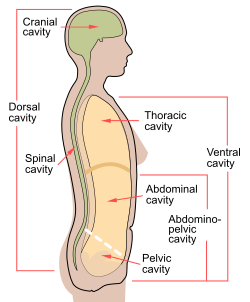
Back Buikwand Afrikaans جدار البطن Arabic উদরীয় প্রাচীর Bengali/Bangla Bugvæg Danish Bauchwand German Pared abdominal Spanish دیواره شکم Persian Paroi abdominale French 배벽 Korean Ściana jamy brzusznej Polish
| Abdominal wall | |
|---|---|
 Body cavities | |
 Diagram of sheath of rectus above the arcuate line. | |
| Details | |
| Identifiers | |
| Latin | paries abdominalis |
| MeSH | D034861 |
| FMA | 10429 |
| Anatomical terminology | |
In anatomy, the abdominal wall represents the boundaries of the abdominal cavity. The abdominal wall is split into the anterolateral and posterior walls.[1]
There is a common set of layers covering and forming all the walls: the deepest being the visceral peritoneum, which covers many of the abdominal organs (most of the large and small intestines, for example), and the parietal peritoneum—which covers the visceral peritoneum below it, the extraperitoneal fat, the transversalis fascia, the internal and external oblique and transversus abdominis aponeurosis, and a layer of fascia, which has different names according to what it covers (e.g., transversalis, psoas fascia).[2]
In medical vernacular, the term 'abdominal wall' most commonly refers to the layers composing the anterior abdominal wall which, in addition to the layers mentioned above, includes the three layers of muscle: the transversus abdominis (transverse abdominal muscle), the internal (obliquus internus) and the external oblique (obliquus externus).[1][2][3]
- ^ a b Moore, Keith L.; Dalley, Arthur F.; Agur, Anne M.R. (2014). Clinically Oriented Anatomy. Philadelphia, PA: Lippincott Williams & Wilkins. pp. 180–186. ISBN 978-1-4511-1945-9.
- ^ a b Cite error: The named reference
:1was invoked but never defined (see the help page). - ^ "Duke Anatomy - Lab 5: Anterior Abdominal Body Wall & Abdominal Viscera". web.duke.edu. Retrieved 2019-09-02.